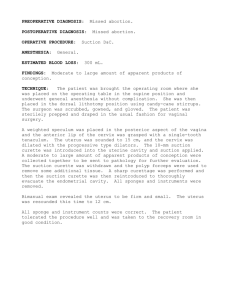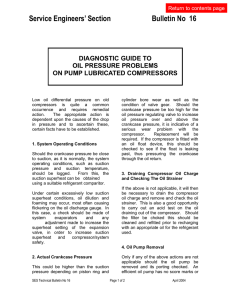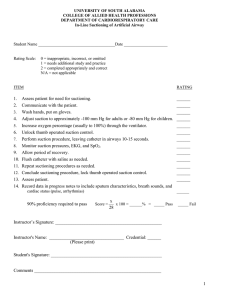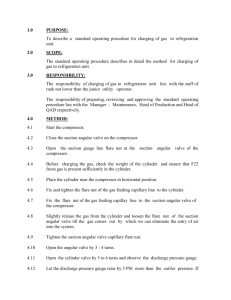Blocked Suction Unloading Improves Part Load - Purdue e-Pubs
advertisement
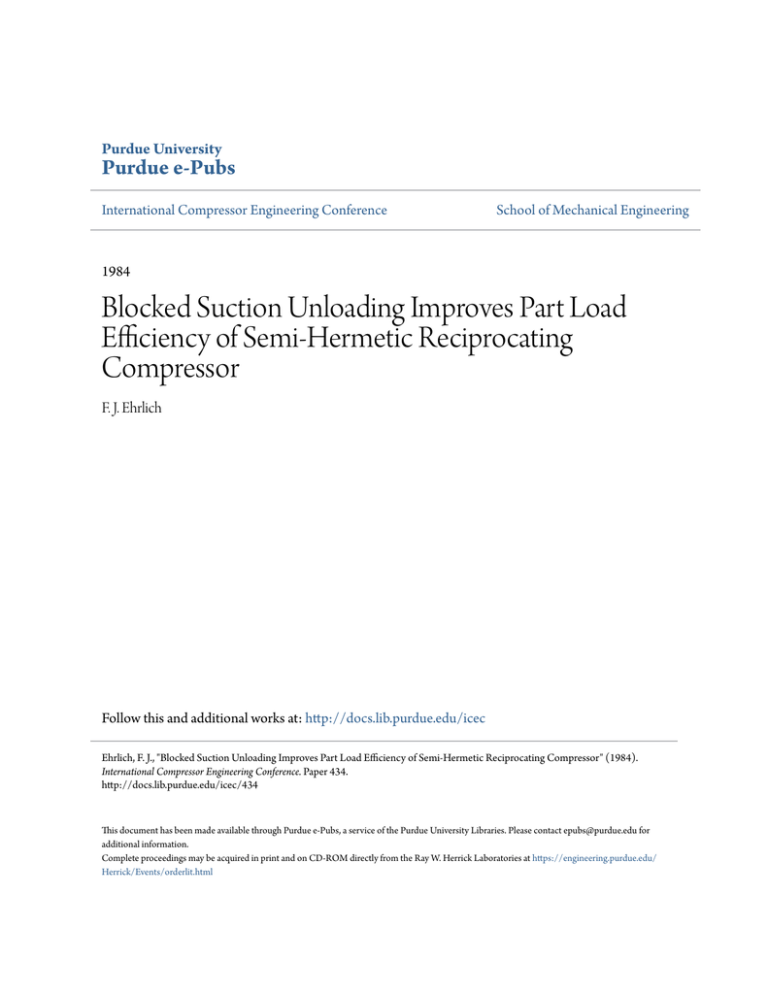
Purdue University Purdue e-Pubs International Compressor Engineering Conference School of Mechanical Engineering 1984 Blocked Suction Unloading Improves Part Load Efficiency of Semi-Hermetic Reciprocating Compressor F. J. Ehrlich Follow this and additional works at: http://docs.lib.purdue.edu/icec Ehrlich, F. J., "Blocked Suction Unloading Improves Part Load Efficiency of Semi-Hermetic Reciprocating Compressor" (1984). International Compressor Engineering Conference. Paper 434. http://docs.lib.purdue.edu/icec/434 This document has been made available through Purdue e-Pubs, a service of the Purdue University Libraries. Please contact epubs@purdue.edu for additional information. Complete proceedings may be acquired in print and on CD-ROM directly from the Ray W. Herrick Laboratories at https://engineering.purdue.edu/ Herrick/Events/orderlit.html BLOCKED SUCTION UNLOADING IMPROVES PART LOAD EFFICIENCY OF SEMI-HERMETIC RECIPROCATING COMPRESSOR Fred J. Ehrlich Chief Engineer, Reciprocating Compressors Borg-Warner Air Conditioning, Inc., York, PA The percent of capacity for each step of unloading is determined by the number of working cylinders divided by the total number of cylinders in the compressor. For example, a six cylinder compressor with only 4 cylinders pumping is at 67% capacity, 2/3 of the cylinders pumping. ABSTRACT This paper illustrates the improvement in part load efficiency of a semi-hermetic reciprocating compressor gained by using blocked suction unloading. The efficiency and operation of blocked suction unloading is compared with top head unloading and suction valve lifter unloading. Of greater importance than having steps or percentage of unloading is the method used to unload the compressor cylinder. The method has a decided effect upon the This overall efficiency of the system. is because systems do not need to operate at full capacity all the time and therefore the compressor need not operate at Because full capacity all the time. compressors do operate at part load, part load efficiency becomes very important in the overall efficiency of the real world system, A description is given for each of the three types of unloading. In addition to having the best part load efficiency, blocked suction unloading results in lower motor temperatures when compared to top head unloading. In conclusion, blocked suction unloading is shown to be the most efficient of the three methods for unloading compressor cylinders. Three of the most widely used methods for unloading compressor cylinders are top head unloading, (THU), suction valve lifter unloading, (SVL) and blocked suction unloading, (BSU).[l] INTRODUCTION In order to more closely match compressor output or capacity to system requirements or load, it is necessary to design some type of compressor cylinder unloading into reciprocating compressors used in air conditioning and refrigeration systems. As system requirements or loads change, the compressor output, or capacity can then be Therefore, changed to match the load. compressor cylinder unloading provides for a gradual compressor capacity transition. Six cylinder compressors can be unloaded from 100%, or full load, in steps, down to 33% capacity, where only two cylinders are Four and eight cylinder comprespumping. sors can be unloaded from 100% or full load, in steps, down to 25% capacity, where only one or two cylinders are pumping. Top Head Unloading (THU) Top head unloading (THU) is accomplished by connecting the discharge head over one or more compressor cylinders to the This is suction side of the compressor. done by a top head unloading valve which can connect the discharge head to either the suction or discharge side of the compressor. See Fig. 1. Normally, of course, the discharge head is connected to the When discharge side of the compressor. the discharge head is connected to the suction side of the compressor, gas is pumped through the cylinder but is not In compressed to discharge pressure. effect, the cylinder or cylinders become unloaded because no gas is delivered to the discharge side of the compressor, Since the gas does flow through the cylinder and back to the suction side of It is necessary that at least one or two cylinders remain permanently loaded so This long as the compressor is running. minimum flow of gas is necessary to cool the motor and the other unloaded cylinders. 56 1.~ TO COMPR DISC.H DISCH Ht!AO TOP HEAD UN LOADER. 1.50 VALVE \.40 6 CYL. COMPRESSOR. J TOP HE.AO UNl..OAC tNe. z g 1,30 ri. 1.20 UJ I 0.. 1.10 1.00 SUCTION .90 FIGURE 1. TOP HEAD UNLOADING, (THU) SHOWN UNLOADED TO COMPRESSOR SUCTION .80 NO. CYLS. the compress or, pressure losses develop as the gas flows through the valves. One pressure loss results as the gas is pulled into the cylinder through the suction valve. A second pressure loss occurs as the gas is pushed out of the cylinder through the discharg e valve. A third pressure loss occurs as the gas is pushed back to the suction side from the discharge head through the unloadin g valve. These three pressure losses account for most of the inefficie ncy of top head unloading. See Figure 2 for typical efficienc y, in KW/TON versus the number of cylinder s loaded on a 30 ton six cylinder semi-her metic compress or at 40° evaporat or and 105° condensi ng. ~ / I -I I ~ I 6 4 z. 100 6b.7 33.3 FIGURE 2. EFFICIEN CY, KW/TON VS. NO. OF CYLINDERS WORKING AND % CAPACITY Suction Valve Lifter Unloadin g (SVL) Suction valve lifter unloadin g (SVL) is accompli shed by lifting the suction valve and keeping it off its seat and open at all times when cylinder unloadin g is desired. See Figure 4. This causes gas to be pulled into the compress or cylinder through the open suction valve when the piston travels from top dead center to bottom dead center. When the piston travels from bottom dead center to top dead center, the same gas is pushed back out of the cylinder through the same suction valve which is being held open. There is no compress ion of gas in the cylinder to discharg e pressure since the cylinder is continuo usly open to the suction side of the compress or. There are two valve pressure losses associate d with suction valve lifter unloadin g. One pressure loss results from the flow of gas through the open suction valve, into the cylinder . The second pressure loss results from the flow of gas out of the cylinder through the open suction valve and back to the suction plenum. These two valve pressure losses account for most of the inefficie ncy of suction valve Top head unloadin g, when piped as shown in Figure 1, causes an increase in the compressor suction temperat ure which in turn causes an increase in the compress or discharge temperat ure. It also causes an increase in motor temperat ure due to the higher suction temperat ure. See Figure 3. All these temperat ure increase s are undesirabl e. They occur because with this type of unloadin g, gas from the unloaded cylinder s is repeated ly recircula ted across the warm motor. Particul arly when there are more unloaded cylinder s than working or pumping cylinder s in a compressor, then most of the compress or suction gas will be made up of recirculated gas as opposed to fresh cooler gas from the evaporat or. Conseque ntly, suction temperat ure, discharg e temperat ure and motor temperat ures rise. 57 ..... 2:ex.. z60 y .-I\- ~ 1.60 DISC. H TEMP. 1.50 2-.... CYL. COMPRESSORS 1.40 z ~ 20 1.30 ri. 1.20 ll w 0 U1 rt M ..... ~ !J) Ill 4Q 0.. :J rt. 6 (l 5 / v ~ 'Y MOTOR 1.10 1.00 TEMP. .90 2 zo r- .80 u.l NO. 8 CYLS. 6 4 z. 100 bb.7 33.3 SUCTION PeRCENT TEMP. 6 4 EFFICIENCY KW/TON VS NO~ OF FIGURE 5. CYLS WORKING AND % CAPACITY, THU & SVL 2 NO· 01=- CYI... I NDE.R.S See Figure 5 for lifter unloading. typical suction valve lifter efficiency in KW/TON versus the number of cylind~rs loaded on a 30 ton six cylinder semihermetic compressor at 40° evaporator and It compares favorably 105° condensing. with top head unloading efficiency, also shown on Figure 5. FIGURE 3. TEMP. DEG. F VS NO. OF CYLS WORKING IN AN 8 CYL COMPR, TOP HEAD UNLOADING SUCTION VALVE. Dl ScHARGE. I-lEAC L.IJ:TE.R PINS HOI. D SUCTION In addition, there is no suction gas temperature increase because there is no gas recirculating across the motor as in top head unloading. VALVE: OPEN Blocked Suction Unloading (BSU) Blocked suction unloading (BSU) is accomplished by literally blocking the flow of gas to the compressor cylinder. It is done by a blocked See Figure 6. suction unloader valve in the suction plenum just before the compressor It stops the cylinder suction valve, flow of suction gas to the cylinder. The compressor piston automatically pumps all the available gas to the discharge side This causes the sucof the compressor. tion plenum between the blocked suction SUCTION SUCTION VALVE LIFTER UNLOADING FIGURE 4. SHOWN UNLOADED 58 DISCHARGE HEAO AT DISCH PRESSURE DISCHARGE HEAD DISCH PRESSUR.E AT BLOCKE.O "SUCTION 8LOCKEO SUCTION VALVE CL.OSE.O VAL.VE OPEN SUCTION FIGURE 6. BLOCKED SUCTION UNLOADING (BSU) SHOWN UNLOADED WITH SUCTION BLOCKED FIGURE 7. BLOCKED SUCTION UNLOADING (BSU) SHOWN IN LOADED POSITION unloader valve and the compressor cylinder valve to be pulled down into a deep vacuum where it remains. The gas in the cylinder varies from a vacuum to discharge pressure and back to a vacuum as it is compressed and re-expands with each stroke of the piston. There is no flow of gas out of the cylinder to the discharge side, and there is no flow of gas into the cylinder from the suction plenum which is in a vacuum. Basically, there is no flow of gas through either the suction valve or the discharge valve. With the exception of irreversibility losses, the work done on the gas during the piston compression stroke is returned during the re-expansion stroke. Since there is no flow of gas, there is no gas recirculating across the motor as in top head unloading. When the blocked suction valve is opened, of course, there is the normal flow of gas to the cylinder, see Figure 7. When the blocked suction valve is closed and there is no flow of gas, there are no valve pressure losses, which accounts for the improved efficiency of blocked suction unloading as compared to top head unloading or suction valve lifter unloading. See Figure 8 where the KW per ton efficiencies of all three are compared. Because there is no gas recirculating across the motor, there is a decrease jn motor temperature when unloading occurs. See Figure 9. Compared to top head unloading where motor temperature increases, with blocked suction unloading the motor temperature decreases. J.£0 I.So 6 CYL. COMPRESSORS 1.4a z 0 ~ 1.30 ri. 1.20 Ul (l_ 5 '::1. 1.10 r.oo .90 .80 NO. CYLS. PERCENT With all of its advantages, the most critical problem with blocked suction unloading is leakage. It is absolutely necessary to establish and maintain a 6 4 z. 100 6h.7 33.3 FIGURE 8. EFFICIENCY KW/TON VS NO. OF CYLS WORKING AND % CAPACITY, THU, SVL, BSU 59 2~eo 260 -"".\.- ~ y~ 2....... SUCTION VALVE. DISC.\4 Dl5CH. VA\..VE TeMP UNLOAOER.. s~ - VALVE SEAT 220 ' ll200 0 -PI'. 40 CYL. SLEEVE. TO COMPR. I-lOUSlNG / 1/:) ,.., -5fr 20 / MOTOR. BOTH ENDS TEMP. ~ PLACES WHERE GOOD SEALS ARE FIGURE 10. REQUIRED TO MAINTAIN VACUUM IN BLOCKED SUCTION PLENUM cc:. 100 Conclusion '"'. esu When compared to top head unloading, blocked suction unloading is significantly more efficient and also results in lowering rather than raising motor and operating temperatures. SUCTION TEMP. _I:/) 8 6 4 Blocked suction unloading is slightly more efficient than suction valve lifter unloading, and both have relatively no ill effects upon the motor or operating temperatures. z NO· OF CY'L I NO EI<.S For blocked suction unloading, it is of utmost importance to establish and maintain a vacuum in the unloaded or blocked suction plenum, TEMP. DEG. F VS NO. OF CYLS FIGURE 9. WORKING IN AN 8 CYL COMPR WITH THU AND IN A 6 CYL COMPR WITH BSU vacuum in the suction plenum leading to See Figure 10. the unloaded cylinders. If a small amount of gas leaks into the suction plenum, it will be drawn into the compressor cylinder where it will be compressed and pumped to the discharge side This pumped leakage of the compressor. gas is extremely hot since it is being compressed from a vacuum to full disThe high compression charge pressure. ratio quickly results in elevated comcompressor discharge temperatures and A nonelevated oil temperatures. leaking seal at the blocked suction valve as well as leak-proof seals elsewhere in the suction plenum and at the discharge valve is essential to blocked suction unThe success of blocked suction loading. unloading depends upon it. Notation THU SVL BSU Top Head Unloading Suction Valve Lifter Unloading Blocked Suction Unloading Reference [1] Cheney, L,W,, A New Approach to Compressor Capacity Modulation, 1974 Purdue Compressor Technology Conference pp 55-60. 60
